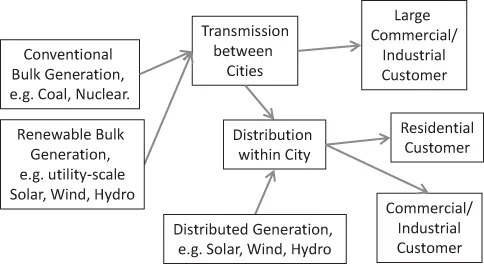
Solarnomics
Setting Up and Managing a Profitable Solar Business
David Wright
- 248 Seiten
- English
- ePUB (handyfreundlich)
- Über iOS und Android verfügbar
Solarnomics
Setting Up and Managing a Profitable Solar Business
David Wright
Über dieses Buch
Solar power has come of age. Not only has it become one of the key alternatives to fossil fuels, it can now be deployed in a way that makes a viable business with a financial profit. This book shows industry professionals and students how to do just that.
Solarnomics describes the economics of building and operating a solar power plant today and provides a window into a future in which several technologies collaborate, and in which all participants in the electricity grid become smarter at scheduling both the supply and demand for electric power to give humanity a future that is sustainable, both environmentally and economically. The book shows how to estimate costs and revenues, how to tweak the design of a project to improve profitability, how to calculate return on investment, how to assess and deal with risk, how to raise capital, how to combine solar with batteries to make a hybrid microgrid, and how to be prepared for future developments in the evolving smart electricity grid.
Solarnomics will enable professionals in the solar industry to assess the potential profitability of a proposed solar project, and it will enable students to add an extra dimension to their understanding of sustainability.
Häufig gestellte Fragen
Information
Part 1 Deploying Solar: Costs and Revenues
- Utility-scale: large installations feeding directly into the electricity grid, the same way that a nuclear power station feeds into the grid. They benefit from more economies of scale than the other types of deployment.
- Commercial and industrial behind-the-meter: medium-sized installations at a customer premises, mainly generating electricity that is used by the customer (rather than being fed into the grid, as with utility-scale deployments). At an office building, the installation is typically on the roof or as an awning over a parking lot. Mounting modules on the ground is less costly and is used at some industrial sites if there is sufficient space.
- Small business and residences behind-the-meter: small installations on individual rooftops (e.g. on strip malls and houses) used primarily to reduce purchases of electricity from the grid (as with the commercial and industrial deployments). The layout of modules needs to be customized to individual roof architectures increasing the cost of these installations.
- Off-grid: not just the iconic log cabin in the woods, but also villages in rural areas and mining operations in remote regions. The key issue here is how to provide electricity after the sun has set, so storage (e.g. batteries) and/or another power source (e.g. wind or hydro) is much more important here than in the previous three deployment scenarios.
- We might not want to. If the value of electricity is more in the afternoon than in the morning, we would angle them slightly west, where the sun is at the time when our electricity is more valuable.
- We might not be able to. On the roof of an office tower, in a windy city like Chicago we might tilt them much less than the latitude (42° for Chicago), because a storm would cause undue stress to the modules themselves, the racking and possibly to the roof of the building. A flatter installation of 10° − 25° might be required by local building codes. Suppose we install them at 22° in Chicago, i.e. 20° away from optimal, we can expect a reduction in electricity output by about 6%.
Electric Power
Electric Energy
Buying Solar Modules to Generate Electric Power
Buying Batteries to Store Electric Energy

Players in the Electricity Grid
- Bulk generators like natural gas, coal, hydro, nuclear and large solar farms compete with each other to supply electricity to the electricity grid. They are typically connected to the transmission network.
- Transmission companies (sometimes called transmission system operators (TSOs)) operate those lines of pylons we see straddling the countryside and delivering power to individual cities. Bulk generators including large solar farms feed power into the transmission network.
- Once electricity arrives at a city, it is transferred from the transmission company to the distribution company (sometimes called the distribution system operator (DSO)), which distributes it throughout that city to end-customers. Smaller-scale solar farms may sell directly to the distribution companies. Distribution companies are highly regulated since they are in a monopoly position, maintaining and controlling the wires and equipment that deliver power to customers.
- The independent systems operator (ISO) balances supply and demand in the public electricity grid (e.g. by operating wholesale markets for electric power), including day-ahead and intra-day markets; see also Chapters 11 and 12. Large consumers of power also have market access and can buy when the price is low. For instance, a cement factory may have its own natural gas generators and can switch them off and buy from the grid if the price is lower. It takes time to ramp up and down the power from nuclear and coal-fired power stations, so they cannot respond quickly to price fluctuations and instead typically provide baseload power under long-term contracts. In North America, there are nine system operators, and some of the larger ones, spanning several U.S. states, are known as regional transmission organizations (RTOs). In some jurisdictions, the ISO and TSO are the same organization.
- Government regulators control the prices charged to residences and businesses acc...